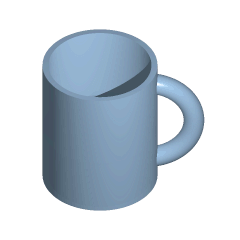
Today we gave presentations about various math topics ranging from the Rubik’s cube to a torus. We discussed the idea that a coffee mug is topologically “equivalent” to a donut (see image to the left). We also discussed $latex \pi$ and $\latex \tau$. We learned why some mathematicians argue that $latex \pi$ is wrong (see The Tau Manifesto).
One of the highlights was receiving a response from one of the mathematicians we interviewed. Please see the interviews and the response below. Thanks so much to Dr. Morgan for responding to Melina and Sam.
Dear Dr. Morgan,
My name is Melina. I am attending SCATS (The Summer Camp for Academically Talented Middle School Students) at Western Kentucky University and I have a few questions I hoped you could answer. First of all, I think that it is pretty cool that you got your Ph. D from Princeton University. I saw your video called “dancing in the parkway.” I love to dance. I major in contemporary. I was wondering, what is it like to be a professor? My sister wants to get her undergraduate from Harvard. She wants to be a Nero Biologist. I want to major in the preforming arts. I was also wondering, how much does a mathematician make per year? I was wondering because if I ever change my mind, I would want to know how much money I would be making. My teacher, Tyler Clark says that he has met you before. I think that’s cool. Also, how old are you? Do you have any pets? Who is your favorite mathematician? Who is you favorite president and why? It would be very kind of you to take your time and write back. I am sure you are very busy.
Sincerely,
Melina
Dear Melina,
Good for you. Dancing and mathematics both take lots of effort and creativity. Mathematicians are well paid and often do lots of travel. A year or two ago I went on an Asian speaking tour, 41 talks in eight weeks in six countries: Pakistan, Vietnam, Thailand, Singapore, Malaysia, and the Philippines:
http://math.williams.edu/math-in-asia-2/
I just got back from a math conference on the beach in Rio, Brazil. I have a pet cat, Everest, who doesn’t seem to mind that I travel a lot. My favorite mathematician was my PhD thesis advisor, Fred Almgren, who passed on 15 years ago. He never let anything stop him from proving his theorem. I think that George Washington was our greatest president. He could have been a king or dictator, but instead he made America the democracy that it is today.
Check out my Huffington Post blog http://www.huffingtonpost.com/frank-morgan/ and keep me posted on your progress.
Sincerely,
Frank Morgan
Atwell Professor of Mathematics, Williams College
http://math.williams.edu/morgan
To: Dr. Morgan
My name is Samuel, and I am attending a summer camp at Western Kentucky University called SCATS (The Summer Camp for Academically Talented Middle School Students). I am writing to you because I wish to know about your mathematical career.
- What is a double bubble?
- How did you prove it?
- Do you enjoy your work?
- What made you pursue mathematics?
- Wikipedia says that you are a dancer, is this true? (I have watched Dancing in the Parkway)
- What all have you studied?
- How was Princeton and MIT?
- What are isoperimetric problems?
Sincerely,
Samuel
Dear Sam,
When two soap bubbles come together they form a double bubble, enclosing and separating two volumes of air. They seem to always produce the same shape, and we proved that that shape is the most efficient, the one with the least total surface area. The first major advance was made by one of my former undergraduate research students, who proved that they don’t break up into lots of pieces. The completion of the proof, with two mathematicians from Granada, Spain, showed that all remaining possibilities were inferior. It was great fun working on this problem with students and mathematicians from around the world. I also love teaching, the other major part of my job. I’m certainly no professional dancer, but dancing is fun. At MIT I majored in math, but I enjoyed physics and computer science and my favorite courses were in literature. Graduate school at Princeton was of course much more focused on mathematics, but it was fun to be part of a great group of fellow math grad students. The double bubble problem was an example of an isoperimetric problem: to minimize surface area or “perimeter” for given volume.
Check out my Huffington Post blog http://www.huffingtonpost.com/frank-morgan/ and keep me posted on your progress.
Sincerely,
Frank Morgan
Atwell Professor of Mathematics, Williams College
http://math.williams.edu/morgan
